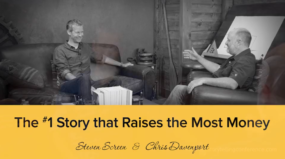I’m going to list a handful of questions I get all the time about donor newsletters.
My answers are going to be super-prescriptive, meaning I’m going to eliminate the gray area and just tell you what I would do.
Every answer has been tested to work better than (i.e., raise more money than) whatever approach was used previously. In most cases, the answers have been tested and found more effective hundreds of times.
Let’s get to it!
Questions & Answers
“What should the newsletter be about?”
It should be about your donor, and the effects of her previous gift. It should not be about your organization.
“What should the stories be about?”
Roughly 2 out of 3 stories should be about a single beneficiary. If you don’t have beneficiaries, then 2 out of 3 stories should directly show and tell your donor the impact her gift made.
“Should the stories all be about one thing?”
Yes. In our experience, newsletters that are themed – all the stories are about one portion of what your organization does – will raise the most money.
“What should I do to make my newsletter raise money?”
The back page of your newsletter should feature what we call a “story of need.” Describe a current need your organization or your beneficiaries are facing, and how the donor’s gift today will help meet that need. (Many donors would like to make a gift after hearing that their previous gift made a difference, and this story gives them a reason to make a gift now.). Additionally, your newsletter should also include a separate reply card and reply envelope.
“What should my reply card look like?”
It should look like a standard appeal reply card. The “action copy” that describes what the donor’s gift will do should tell the donor that her gift will meet the need that’s mentioned on the back page of your newsletter.
“What grade level should I write at?”
Around 7th or 8th grade. Writing at this grade level has nothing to do with the intelligence of your readers, or how intelligent they will think your organization is. It has everything to do with how fast and easy it is for them to understand what they’re reading.
“What will people be most likely to read?”
Your headlines, subheads and picture captions. Make sure that if a donor reads only those elements she will receive your main message: that her gift made a meaningful difference. Be sure to devote the appropriate amount of time to these elements; they are the most-read parts of your newsletter, so you should spend more time on them than you do on the stories themselves.
“What is the purpose of the donor-centric newsletter?”
Primary purpose: to show and tell your donor that her previous gift made a difference. Secondary purpose: for the donors who are now inspired to help even more, to make it easy for them to give a gift today.
“How often should the newsletter mention the donor?”
She should be mentioned in every story. You accomplish this by using the word “you.” In most stories she should be mentioned at least twice.
“Am I writing to all donors?”
No. Write as if only one person is going to read it.
“Who should I send this to?”
All donors who have given a gift in the last 18 months.
“Can I send it to our volunteers / lapsed donors / non-donors?”
You can, but it’s a waste of your money. Newsletters are empirically lousy at turning non-donors into donors (we’ve tested it). And if you include content in your newsletter for volunteers, your newsletter is less effective for donors.
Want More?
Those answers will help your newsletter start raising more money immediately.
If you’d like help taking your next newsletter from blank page to a donor-delighting, money-raising newsletter, take the Newsletters webinar I created with Chris Davenport (the founder of the Nonprofit Storytelling Conference).
You’ll see our super-simple template for your newsletter. It makes it as easy as possible for you. And I’ll walk you through all of the steps.
We received one quote that made my month: “Thank you so much for the webinar series – the best training $$s I’ve spent in the last 5 years.”
Steven Screen is Co-Founder of The Better Fundraising Company and lead author of its blog. With over 30 years' fundraising experience, he gets energized by helping organizations understand how they can raise more money. He’s a second-generation fundraiser, a past winner of the Direct Mail Package of the Year, and data-driven.








